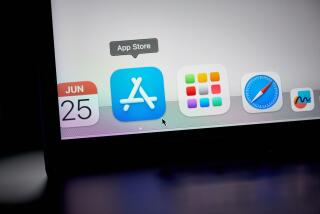Apple’s easing of app rules boosts approvals for developers
- Share via
Bryan Bartow, a software developer in Austin, Texas, invented an iPhone application he called MePing and submitted to Apple Inc. in March.
Six months later, it was still in limbo, neither approved nor rejected.
“It just waited in review forever,” Bartow said. “I just assumed it wasn’t going to be approved, and moved on.”
Then, last week, Bartow got a surprise e-mail from Apple. MePing had been approved.
“It magically came through,” he said.
He was not alone in having his long-delayed app suddenly accepted by Apple — other developers reported that their creations had suddenly come out of the deep freeze and been approved for consumers using the company’s iPhone family of devices.
Apple earned a reputation for keeping an iron grip on its approval process, refusing to let through some apps not made with the company’s own development tools. But last week the company said it would accept apps made with development tools other than its own.
“We have listened to our developers and taken much of their feedback to heart,” Apple said in a statement.
But analysts said the company may have more than matters of the heart to worry about. It could be reacting to mounting competitive and regulatory pressures in the hotly contested smart phone market. Apple rival Google Inc. has succeeded in placing its Android phone software on more than 60 devices, with the result being handsets using its operating system are now outselling iPhones.
“Apple is hearing Google’s footsteps and doing everything it can to stay a couple of feet ahead,” said Yair Reiner, an analyst at Oppenheimer & Co.
Apple may also be looking to placate antitrust officials, who have increasingly scrutinized Apple’s mobile businesses in recent years. In one case, the Federal Communications Commission expressed concern over Apple not approving the Google Voice telephony app.
Perhaps the most visible beneficiary of Apple’s newly relaxed app rules is Adobe Systems Inc., the maker of the Flash set of interactive online software. Despite Apple’s disdain for Flash — Chief Executive Steve Jobs assailed the product in April for what he called performance and security problems — the company relented and will allow Flash developers to translate their apps for the iPhone.
That could bring on a substantial influx of new iPhone apps. Adobe says it has about 3 million developers in its Flash community, and is hoping more programmers will use a tool it created that automatically translates apps written for other devices — such as phones using Google’s Android operating system — over to the iPhone.
“I think we’re going to see more applications that are interactive and engaging that might’ve otherwise been too difficult for developers to build,” said Christian Cantrell, an Adobe product manager who works with mobile platforms. “They’re able to use tools that they’re accustomed to.”
Apple would not comment on the number of new Flash-based apps it had recently approved for the App Store, but evidence of the relaxed policy is beginning to trickle in.
Rob Hall, a Philadelphia-based Flash developer, submitted a version of his event scheduling app, PhillyGeekCentral, in March. It was approved the day Apple announced its rule changes.
Developer Paul Spitzer of Colorado invented a Flash-based app, Spiralz, in March. He heard nothing back from Apple about his creation that draws spirals on the iPhone screen. Frustrated, he finally decided to shell out for some new equipment and software that would enable him to try Apple’s development tools.
He finally got the new tools up and running — just before hearing that Apple had approved Spiralz.
“After all I’d been through,” he wrote in a blog post last week, “I didn’t know whether to cry or rejoice.”
david.sarno@latimes.com






